Co-ownership - Should Joint Tenancies be Abolished as Outdated or All be Deemed to be Tenancies in Common?
VerifiedAdded on 2023/01/19
|12
|4838
|51
AI Summary
This assignment discusses the concept of co-ownership and the debate on whether joint tenancies should be abolished or deemed as tenancies in common. It explores the differences between joint tenancy and tenancy in common, and provides examples and case studies to enhance understanding. The assignment also touches upon the property system in Australia and the laws related to co-ownership.
Contribute Materials
Your contribution can guide someone’s learning journey. Share your
documents today.
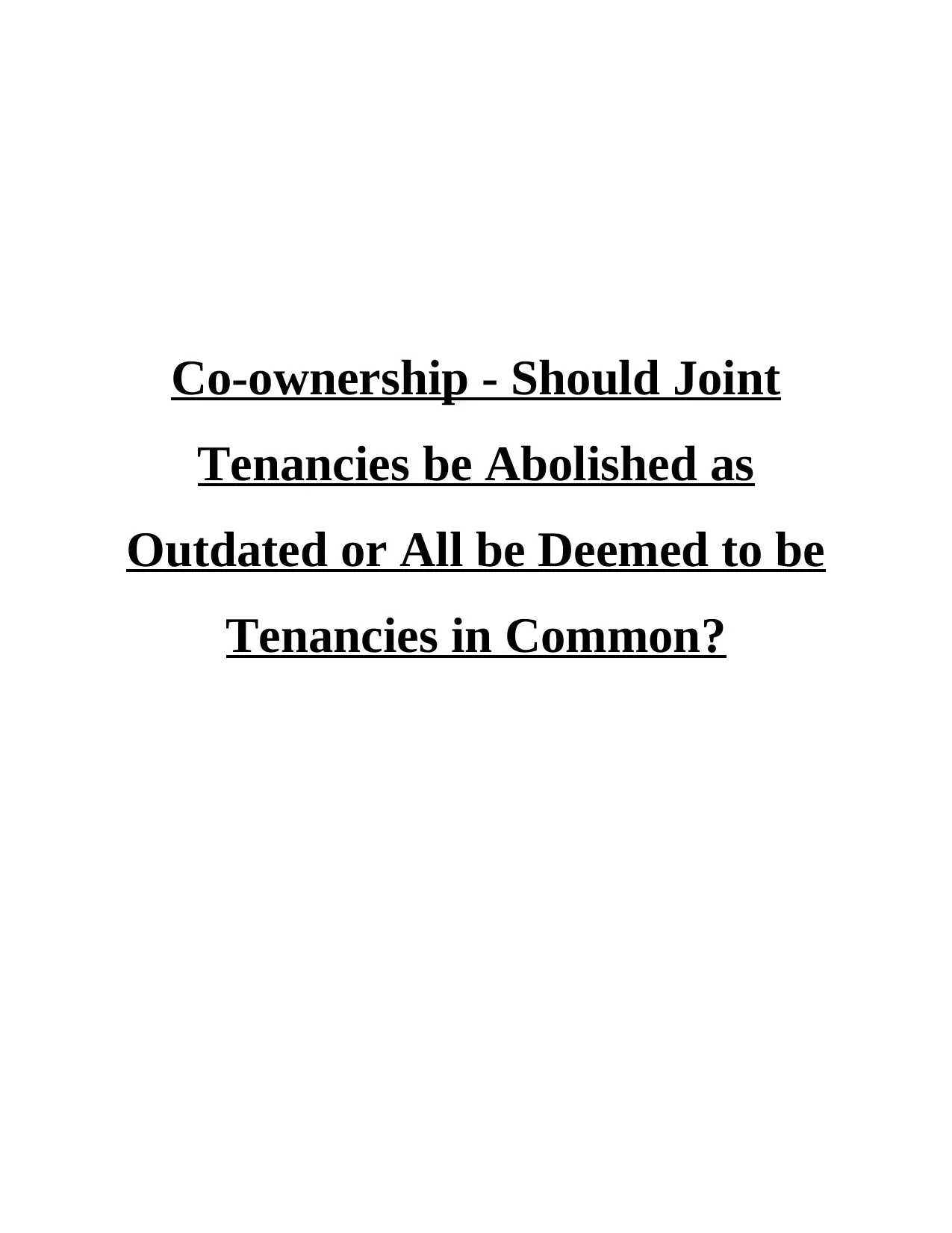
Co-ownership - Should Joint
Tenancies be Abolished as
Outdated or All be Deemed to be
Tenancies in Common?
Tenancies be Abolished as
Outdated or All be Deemed to be
Tenancies in Common?
Secure Best Marks with AI Grader
Need help grading? Try our AI Grader for instant feedback on your assignments.

Table of Contents
INTRODUCTION ..........................................................................................................................3
MAIN BODY ..................................................................................................................................3
CONCLUSION..............................................................................................................................10
REFERENCES..............................................................................................................................11
INTRODUCTION ..........................................................................................................................3
MAIN BODY ..................................................................................................................................3
CONCLUSION..............................................................................................................................10
REFERENCES..............................................................................................................................11

INTRODUCTION
Co-ownership refers to the situation where two or more individuals are holding and
owning some property. In co ownership, there are two different sections which are considered
and each of the two sections are named as legal estate and equitable estate (Rameezdeen, Zuo
and Stevens, 2017). The assignment will makes its focus on the discussion about the topic co-
ownership and will also focus about the abolition of joint tenancies and about the concepts of
tenancies in common. Along with this, in the essay, it will provide examples of different case
studies with the help of which it will be possible to have more knowledge about the topic of
discussion.
MAIN BODY
Discussion
Co-ownership is the term used to depict the types of possession in which at least two
people are simultaneously qualified under lock and key for an intrigue or interests in a similar
property (Parrett, 2017). The law of co-ownership is a result of rule and the precedent-based law,
the Law of Property Act and the Trusts of Land and Appointment of Trustees Act 1996, which
are significant. There are two sorts of co-ownership: Joint Tenancy and Tenure in Common.
Joint Tenancy is a type of co-ownership in which every individual is completely qualified for the
entire of the domain (Ong, 2018). Inside a joint tenure the joint occupants appreciate as between
themselves a privilege of survivorship and there is constantly an assumption of four solidarities
being available.
The law consistently says that for a joint tenancy to be accessible every one of the 'four
solidarities' must be available. This has been pictured as 'a careful and private association',
association comprising of four solidarities which are title, time, intrigue and ownership (Davys,
2019). Every one of the titles are gotten from a similar award and become vested simultaneously;
every one of the interests are indistinguishable in size; and there is solidarity of ownership and
every hold the entire as in related to his co-owners he is qualified for present belonging and
satisfaction in the entirety (SEE, 2019). From this time forward no joint occupant may ever say
they possess a specific piece of he land which, is confined to other co-owners represented. The
Co-ownership refers to the situation where two or more individuals are holding and
owning some property. In co ownership, there are two different sections which are considered
and each of the two sections are named as legal estate and equitable estate (Rameezdeen, Zuo
and Stevens, 2017). The assignment will makes its focus on the discussion about the topic co-
ownership and will also focus about the abolition of joint tenancies and about the concepts of
tenancies in common. Along with this, in the essay, it will provide examples of different case
studies with the help of which it will be possible to have more knowledge about the topic of
discussion.
MAIN BODY
Discussion
Co-ownership is the term used to depict the types of possession in which at least two
people are simultaneously qualified under lock and key for an intrigue or interests in a similar
property (Parrett, 2017). The law of co-ownership is a result of rule and the precedent-based law,
the Law of Property Act and the Trusts of Land and Appointment of Trustees Act 1996, which
are significant. There are two sorts of co-ownership: Joint Tenancy and Tenure in Common.
Joint Tenancy is a type of co-ownership in which every individual is completely qualified for the
entire of the domain (Ong, 2018). Inside a joint tenure the joint occupants appreciate as between
themselves a privilege of survivorship and there is constantly an assumption of four solidarities
being available.
The law consistently says that for a joint tenancy to be accessible every one of the 'four
solidarities' must be available. This has been pictured as 'a careful and private association',
association comprising of four solidarities which are title, time, intrigue and ownership (Davys,
2019). Every one of the titles are gotten from a similar award and become vested simultaneously;
every one of the interests are indistinguishable in size; and there is solidarity of ownership and
every hold the entire as in related to his co-owners he is qualified for present belonging and
satisfaction in the entirety (SEE, 2019). From this time forward no joint occupant may ever say
they possess a specific piece of he land which, is confined to other co-owners represented. The
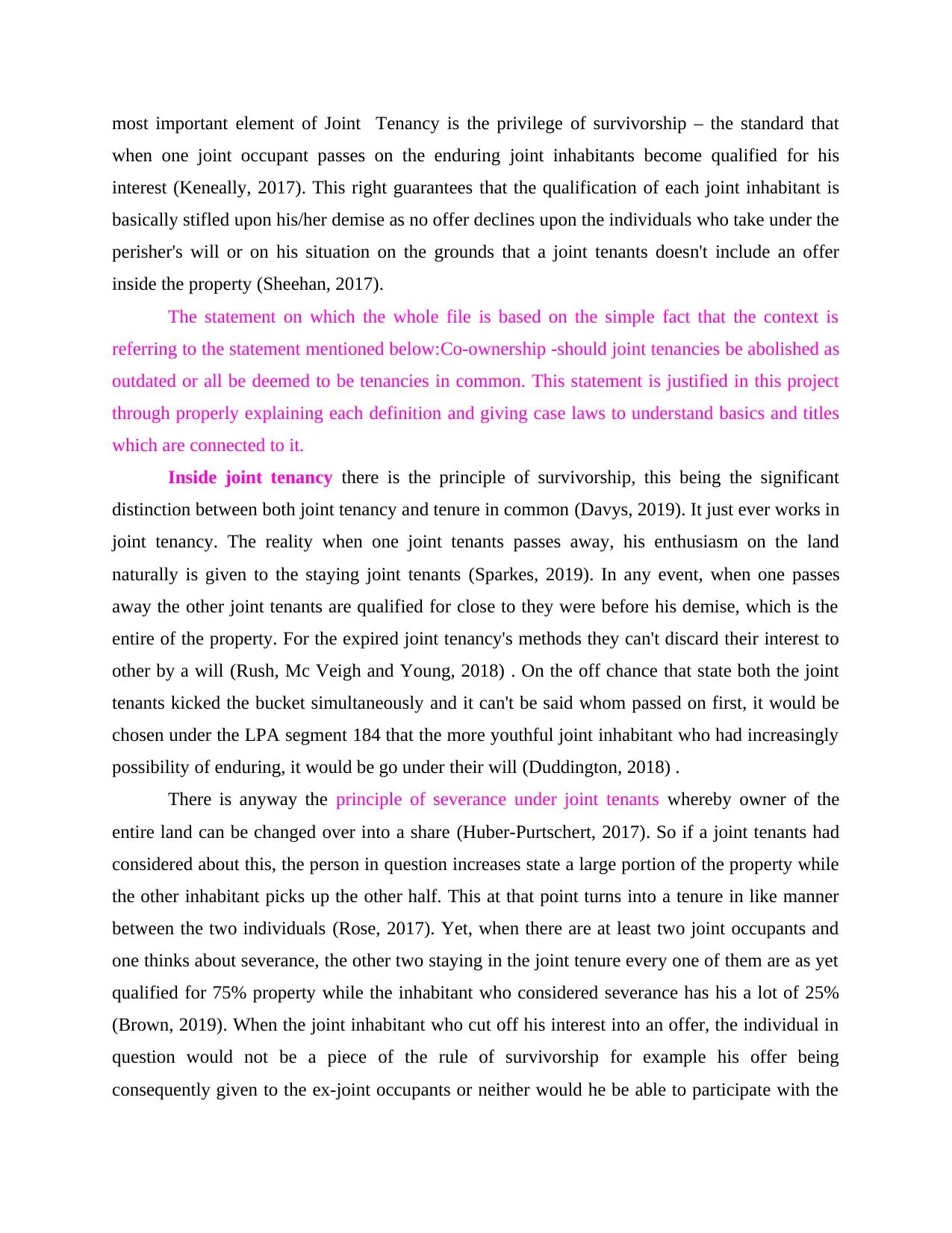
most important element of Joint Tenancy is the privilege of survivorship – the standard that
when one joint occupant passes on the enduring joint inhabitants become qualified for his
interest (Keneally, 2017). This right guarantees that the qualification of each joint inhabitant is
basically stifled upon his/her demise as no offer declines upon the individuals who take under the
perisher's will or on his situation on the grounds that a joint tenants doesn't include an offer
inside the property (Sheehan, 2017).
The statement on which the whole file is based on the simple fact that the context is
referring to the statement mentioned below:Co-ownership -should joint tenancies be abolished as
outdated or all be deemed to be tenancies in common. This statement is justified in this project
through properly explaining each definition and giving case laws to understand basics and titles
which are connected to it.
Inside joint tenancy there is the principle of survivorship, this being the significant
distinction between both joint tenancy and tenure in common (Davys, 2019). It just ever works in
joint tenancy. The reality when one joint tenants passes away, his enthusiasm on the land
naturally is given to the staying joint tenants (Sparkes, 2019). In any event, when one passes
away the other joint tenants are qualified for close to they were before his demise, which is the
entire of the property. For the expired joint tenancy's methods they can't discard their interest to
other by a will (Rush, Mc Veigh and Young, 2018) . On the off chance that state both the joint
tenants kicked the bucket simultaneously and it can't be said whom passed on first, it would be
chosen under the LPA segment 184 that the more youthful joint inhabitant who had increasingly
possibility of enduring, it would be go under their will (Duddington, 2018) .
There is anyway the principle of severance under joint tenants whereby owner of the
entire land can be changed over into a share (Huber-Purtschert, 2017). So if a joint tenants had
considered about this, the person in question increases state a large portion of the property while
the other inhabitant picks up the other half. This at that point turns into a tenure in like manner
between the two individuals (Rose, 2017). Yet, when there are at least two joint occupants and
one thinks about severance, the other two staying in the joint tenure every one of them are as yet
qualified for 75% property while the inhabitant who considered severance has his a lot of 25%
(Brown, 2019). When the joint inhabitant who cut off his interest into an offer, the individual in
question would not be a piece of the rule of survivorship for example his offer being
consequently given to the ex-joint occupants or neither would he be able to participate with the
when one joint occupant passes on the enduring joint inhabitants become qualified for his
interest (Keneally, 2017). This right guarantees that the qualification of each joint inhabitant is
basically stifled upon his/her demise as no offer declines upon the individuals who take under the
perisher's will or on his situation on the grounds that a joint tenants doesn't include an offer
inside the property (Sheehan, 2017).
The statement on which the whole file is based on the simple fact that the context is
referring to the statement mentioned below:Co-ownership -should joint tenancies be abolished as
outdated or all be deemed to be tenancies in common. This statement is justified in this project
through properly explaining each definition and giving case laws to understand basics and titles
which are connected to it.
Inside joint tenancy there is the principle of survivorship, this being the significant
distinction between both joint tenancy and tenure in common (Davys, 2019). It just ever works in
joint tenancy. The reality when one joint tenants passes away, his enthusiasm on the land
naturally is given to the staying joint tenants (Sparkes, 2019). In any event, when one passes
away the other joint tenants are qualified for close to they were before his demise, which is the
entire of the property. For the expired joint tenancy's methods they can't discard their interest to
other by a will (Rush, Mc Veigh and Young, 2018) . On the off chance that state both the joint
tenants kicked the bucket simultaneously and it can't be said whom passed on first, it would be
chosen under the LPA segment 184 that the more youthful joint inhabitant who had increasingly
possibility of enduring, it would be go under their will (Duddington, 2018) .
There is anyway the principle of severance under joint tenants whereby owner of the
entire land can be changed over into a share (Huber-Purtschert, 2017). So if a joint tenants had
considered about this, the person in question increases state a large portion of the property while
the other inhabitant picks up the other half. This at that point turns into a tenure in like manner
between the two individuals (Rose, 2017). Yet, when there are at least two joint occupants and
one thinks about severance, the other two staying in the joint tenure every one of them are as yet
qualified for 75% property while the inhabitant who considered severance has his a lot of 25%
(Brown, 2019). When the joint inhabitant who cut off his interest into an offer, the individual in
question would not be a piece of the rule of survivorship for example his offer being
consequently given to the ex-joint occupants or neither would he be able to participate with the
Secure Best Marks with AI Grader
Need help grading? Try our AI Grader for instant feedback on your assignments.
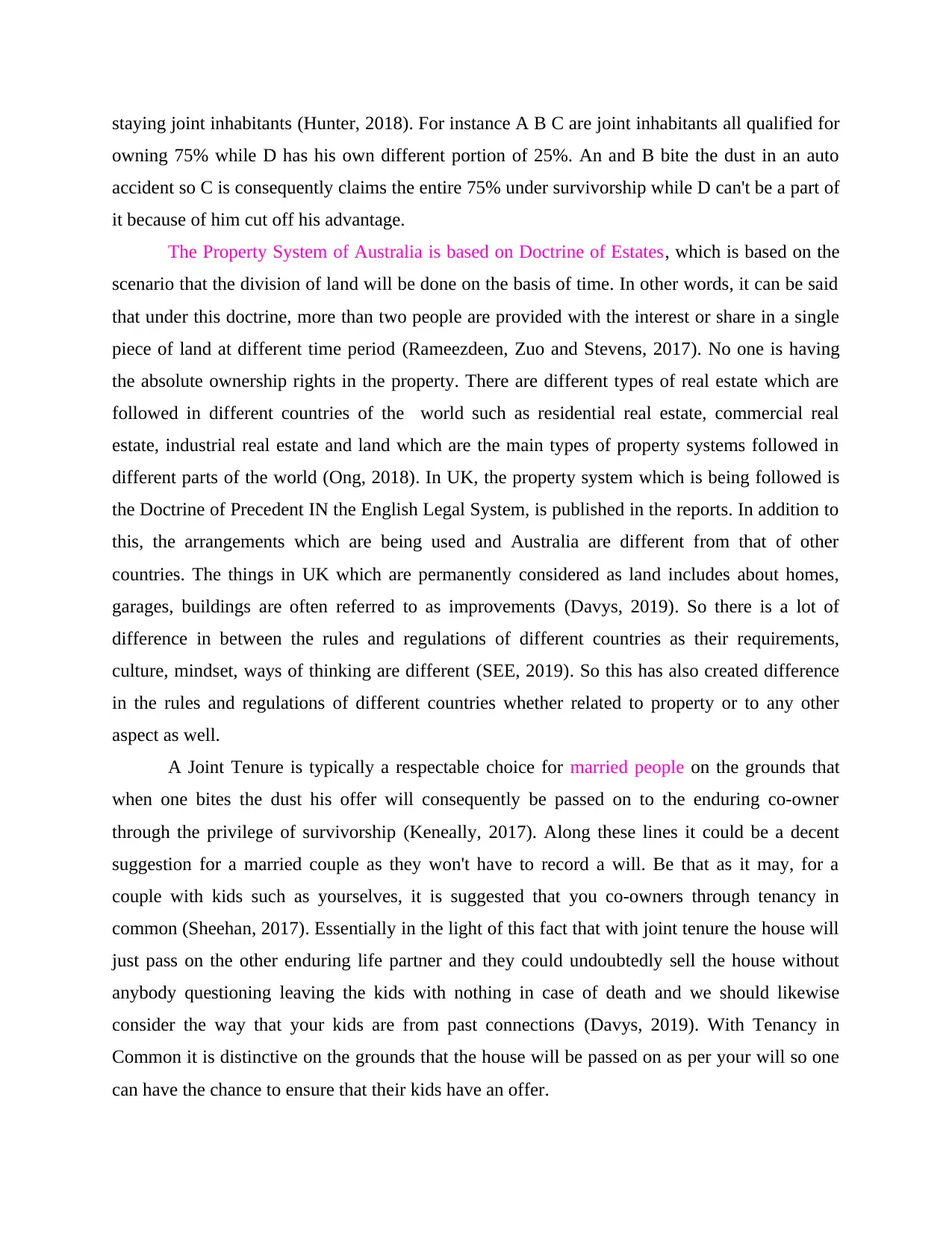
staying joint inhabitants (Hunter, 2018). For instance A B C are joint inhabitants all qualified for
owning 75% while D has his own different portion of 25%. An and B bite the dust in an auto
accident so C is consequently claims the entire 75% under survivorship while D can't be a part of
it because of him cut off his advantage.
The Property System of Australia is based on Doctrine of Estates, which is based on the
scenario that the division of land will be done on the basis of time. In other words, it can be said
that under this doctrine, more than two people are provided with the interest or share in a single
piece of land at different time period (Rameezdeen, Zuo and Stevens, 2017). No one is having
the absolute ownership rights in the property. There are different types of real estate which are
followed in different countries of the world such as residential real estate, commercial real
estate, industrial real estate and land which are the main types of property systems followed in
different parts of the world (Ong, 2018). In UK, the property system which is being followed is
the Doctrine of Precedent IN the English Legal System, is published in the reports. In addition to
this, the arrangements which are being used and Australia are different from that of other
countries. The things in UK which are permanently considered as land includes about homes,
garages, buildings are often referred to as improvements (Davys, 2019). So there is a lot of
difference in between the rules and regulations of different countries as their requirements,
culture, mindset, ways of thinking are different (SEE, 2019). So this has also created difference
in the rules and regulations of different countries whether related to property or to any other
aspect as well.
A Joint Tenure is typically a respectable choice for married people on the grounds that
when one bites the dust his offer will consequently be passed on to the enduring co-owner
through the privilege of survivorship (Keneally, 2017). Along these lines it could be a decent
suggestion for a married couple as they won't have to record a will. Be that as it may, for a
couple with kids such as yourselves, it is suggested that you co-owners through tenancy in
common (Sheehan, 2017). Essentially in the light of this fact that with joint tenure the house will
just pass on the other enduring life partner and they could undoubtedly sell the house without
anybody questioning leaving the kids with nothing in case of death and we should likewise
consider the way that your kids are from past connections (Davys, 2019). With Tenancy in
Common it is distinctive on the grounds that the house will be passed on as per your will so one
can have the chance to ensure that their kids have an offer.
owning 75% while D has his own different portion of 25%. An and B bite the dust in an auto
accident so C is consequently claims the entire 75% under survivorship while D can't be a part of
it because of him cut off his advantage.
The Property System of Australia is based on Doctrine of Estates, which is based on the
scenario that the division of land will be done on the basis of time. In other words, it can be said
that under this doctrine, more than two people are provided with the interest or share in a single
piece of land at different time period (Rameezdeen, Zuo and Stevens, 2017). No one is having
the absolute ownership rights in the property. There are different types of real estate which are
followed in different countries of the world such as residential real estate, commercial real
estate, industrial real estate and land which are the main types of property systems followed in
different parts of the world (Ong, 2018). In UK, the property system which is being followed is
the Doctrine of Precedent IN the English Legal System, is published in the reports. In addition to
this, the arrangements which are being used and Australia are different from that of other
countries. The things in UK which are permanently considered as land includes about homes,
garages, buildings are often referred to as improvements (Davys, 2019). So there is a lot of
difference in between the rules and regulations of different countries as their requirements,
culture, mindset, ways of thinking are different (SEE, 2019). So this has also created difference
in the rules and regulations of different countries whether related to property or to any other
aspect as well.
A Joint Tenure is typically a respectable choice for married people on the grounds that
when one bites the dust his offer will consequently be passed on to the enduring co-owner
through the privilege of survivorship (Keneally, 2017). Along these lines it could be a decent
suggestion for a married couple as they won't have to record a will. Be that as it may, for a
couple with kids such as yourselves, it is suggested that you co-owners through tenancy in
common (Sheehan, 2017). Essentially in the light of this fact that with joint tenure the house will
just pass on the other enduring life partner and they could undoubtedly sell the house without
anybody questioning leaving the kids with nothing in case of death and we should likewise
consider the way that your kids are from past connections (Davys, 2019). With Tenancy in
Common it is distinctive on the grounds that the house will be passed on as per your will so one
can have the chance to ensure that their kids have an offer.
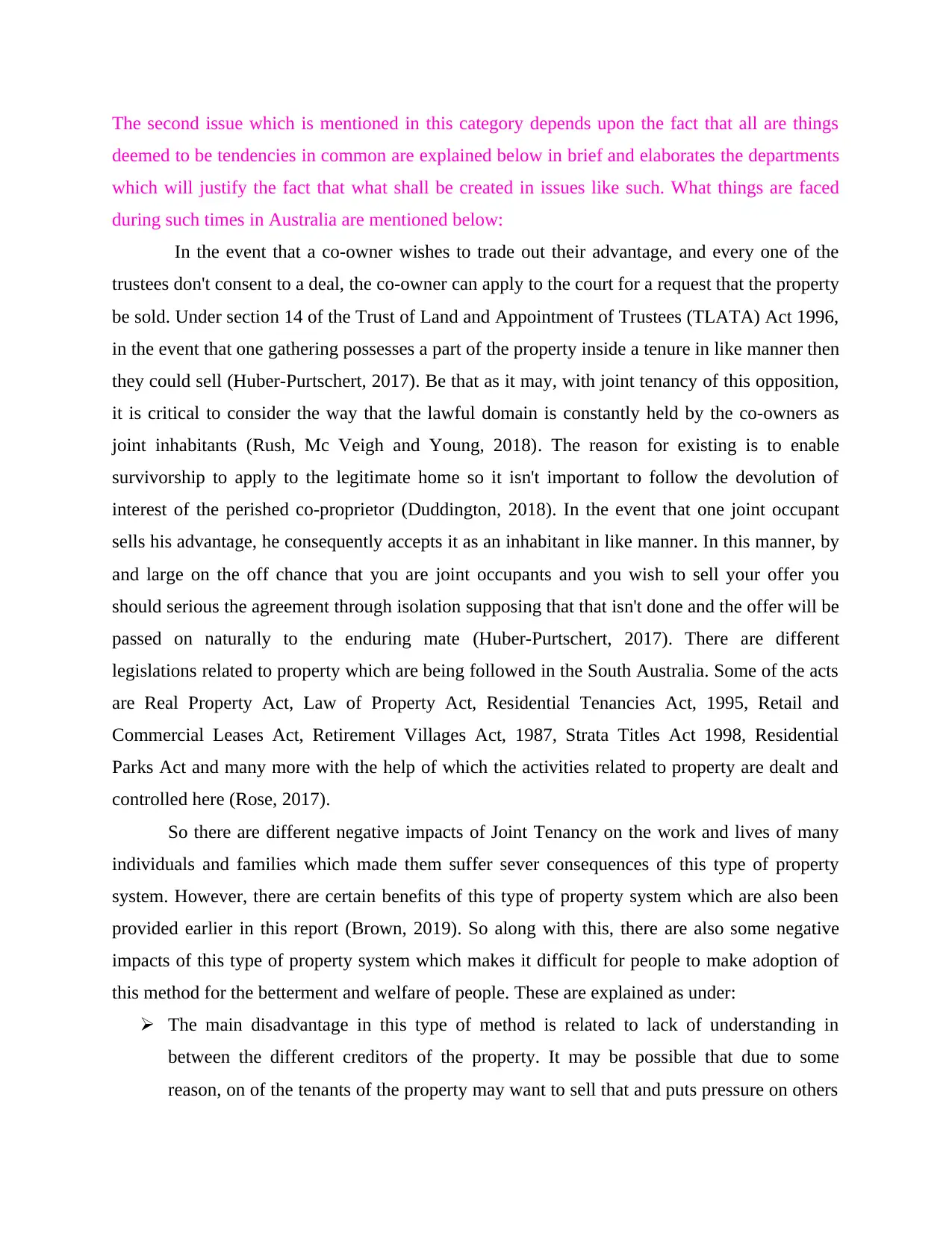
The second issue which is mentioned in this category depends upon the fact that all are things
deemed to be tendencies in common are explained below in brief and elaborates the departments
which will justify the fact that what shall be created in issues like such. What things are faced
during such times in Australia are mentioned below:
In the event that a co-owner wishes to trade out their advantage, and every one of the
trustees don't consent to a deal, the co-owner can apply to the court for a request that the property
be sold. Under section 14 of the Trust of Land and Appointment of Trustees (TLATA) Act 1996,
in the event that one gathering possesses a part of the property inside a tenure in like manner then
they could sell (Huber-Purtschert, 2017). Be that as it may, with joint tenancy of this opposition,
it is critical to consider the way that the lawful domain is constantly held by the co-owners as
joint inhabitants (Rush, Mc Veigh and Young, 2018). The reason for existing is to enable
survivorship to apply to the legitimate home so it isn't important to follow the devolution of
interest of the perished co-proprietor (Duddington, 2018). In the event that one joint occupant
sells his advantage, he consequently accepts it as an inhabitant in like manner. In this manner, by
and large on the off chance that you are joint occupants and you wish to sell your offer you
should serious the agreement through isolation supposing that that isn't done and the offer will be
passed on naturally to the enduring mate (Huber-Purtschert, 2017). There are different
legislations related to property which are being followed in the South Australia. Some of the acts
are Real Property Act, Law of Property Act, Residential Tenancies Act, 1995, Retail and
Commercial Leases Act, Retirement Villages Act, 1987, Strata Titles Act 1998, Residential
Parks Act and many more with the help of which the activities related to property are dealt and
controlled here (Rose, 2017).
So there are different negative impacts of Joint Tenancy on the work and lives of many
individuals and families which made them suffer sever consequences of this type of property
system. However, there are certain benefits of this type of property system which are also been
provided earlier in this report (Brown, 2019). So along with this, there are also some negative
impacts of this type of property system which makes it difficult for people to make adoption of
this method for the betterment and welfare of people. These are explained as under:
The main disadvantage in this type of method is related to lack of understanding in
between the different creditors of the property. It may be possible that due to some
reason, on of the tenants of the property may want to sell that and puts pressure on others
deemed to be tendencies in common are explained below in brief and elaborates the departments
which will justify the fact that what shall be created in issues like such. What things are faced
during such times in Australia are mentioned below:
In the event that a co-owner wishes to trade out their advantage, and every one of the
trustees don't consent to a deal, the co-owner can apply to the court for a request that the property
be sold. Under section 14 of the Trust of Land and Appointment of Trustees (TLATA) Act 1996,
in the event that one gathering possesses a part of the property inside a tenure in like manner then
they could sell (Huber-Purtschert, 2017). Be that as it may, with joint tenancy of this opposition,
it is critical to consider the way that the lawful domain is constantly held by the co-owners as
joint inhabitants (Rush, Mc Veigh and Young, 2018). The reason for existing is to enable
survivorship to apply to the legitimate home so it isn't important to follow the devolution of
interest of the perished co-proprietor (Duddington, 2018). In the event that one joint occupant
sells his advantage, he consequently accepts it as an inhabitant in like manner. In this manner, by
and large on the off chance that you are joint occupants and you wish to sell your offer you
should serious the agreement through isolation supposing that that isn't done and the offer will be
passed on naturally to the enduring mate (Huber-Purtschert, 2017). There are different
legislations related to property which are being followed in the South Australia. Some of the acts
are Real Property Act, Law of Property Act, Residential Tenancies Act, 1995, Retail and
Commercial Leases Act, Retirement Villages Act, 1987, Strata Titles Act 1998, Residential
Parks Act and many more with the help of which the activities related to property are dealt and
controlled here (Rose, 2017).
So there are different negative impacts of Joint Tenancy on the work and lives of many
individuals and families which made them suffer sever consequences of this type of property
system. However, there are certain benefits of this type of property system which are also been
provided earlier in this report (Brown, 2019). So along with this, there are also some negative
impacts of this type of property system which makes it difficult for people to make adoption of
this method for the betterment and welfare of people. These are explained as under:
The main disadvantage in this type of method is related to lack of understanding in
between the different creditors of the property. It may be possible that due to some
reason, on of the tenants of the property may want to sell that and puts pressure on others

as well to sales the property (Hunter, 2018). So this will be a reason due to which this
type of ownership is not preferred and also do not last for much period of time. Issues
could also arise such as bankruptcy, sued or divorce which makes it important to proceed
with the sales of his ownership (Sparkes, 2019).
In addition to this, there is also an increment in the responsibilities of the individuals in
the property as compared to the owners in severalty (Parrett, 2017) . They much pay their
share of taxes, mortgage payments and assessments. They are also required to complete
and pay for their proportion of share of those repairs and maintenance issues which are
necessary.
A few people may buy property with the expectation to experience their life in the home
and afterwards give it to their kids or friends and family at the hour of their passing. In
any case, joint tenants, they don't reserve the privilege to move their interest after their
demise (Rameezdeen, Zuo and Stevens, 2017). They basically stop owning any bit of the
property. This is genuine regardless of whether an individual's will states generally.
At the point when an individual claims property with another person as joint tenants, the
person must get consent from the other joint individuals to make certain courses of action
in regards to the property (Ong, 2018). For instance, the person in question may require
authorization to get a home loan on the home or to move their offer to another person.
This can be troublesome if joint occupants don't concur or get along.
Now and again, changing property from that possessed in severalty to joint tenure may
make blessing assessments emerge (Davys, 2019). A special case to this is if the joint
inhabitants are United States residents who are hitched to one another.
A land legal counsellor with involvement with simultaneous types of ownership can
examine a customer's needs to decide if joint tenure will or won't best serve the customer
(SEE, 2019). Different types of simultaneous possession might be talked about, for
example, inhabitants in like manner and occupants by the sum.
Reviewing the law related policies, about joint tenancies and tenancies in common of
personal and real property, the Commission of Australia in 1994, has commenced to – The
Construction Rules, that govern the creation of tenancies in common and joint tenancies;
Severance of joint tenancy through notice; and whether inheritance should be amended as per
Family and Dependants Provision Act 1972, to empower the constitutional bodies or court for
type of ownership is not preferred and also do not last for much period of time. Issues
could also arise such as bankruptcy, sued or divorce which makes it important to proceed
with the sales of his ownership (Sparkes, 2019).
In addition to this, there is also an increment in the responsibilities of the individuals in
the property as compared to the owners in severalty (Parrett, 2017) . They much pay their
share of taxes, mortgage payments and assessments. They are also required to complete
and pay for their proportion of share of those repairs and maintenance issues which are
necessary.
A few people may buy property with the expectation to experience their life in the home
and afterwards give it to their kids or friends and family at the hour of their passing. In
any case, joint tenants, they don't reserve the privilege to move their interest after their
demise (Rameezdeen, Zuo and Stevens, 2017). They basically stop owning any bit of the
property. This is genuine regardless of whether an individual's will states generally.
At the point when an individual claims property with another person as joint tenants, the
person must get consent from the other joint individuals to make certain courses of action
in regards to the property (Ong, 2018). For instance, the person in question may require
authorization to get a home loan on the home or to move their offer to another person.
This can be troublesome if joint occupants don't concur or get along.
Now and again, changing property from that possessed in severalty to joint tenure may
make blessing assessments emerge (Davys, 2019). A special case to this is if the joint
inhabitants are United States residents who are hitched to one another.
A land legal counsellor with involvement with simultaneous types of ownership can
examine a customer's needs to decide if joint tenure will or won't best serve the customer
(SEE, 2019). Different types of simultaneous possession might be talked about, for
example, inhabitants in like manner and occupants by the sum.
Reviewing the law related policies, about joint tenancies and tenancies in common of
personal and real property, the Commission of Australia in 1994, has commenced to – The
Construction Rules, that govern the creation of tenancies in common and joint tenancies;
Severance of joint tenancy through notice; and whether inheritance should be amended as per
Family and Dependants Provision Act 1972, to empower the constitutional bodies or court for
Paraphrase This Document
Need a fresh take? Get an instant paraphrase of this document with our AI Paraphraser
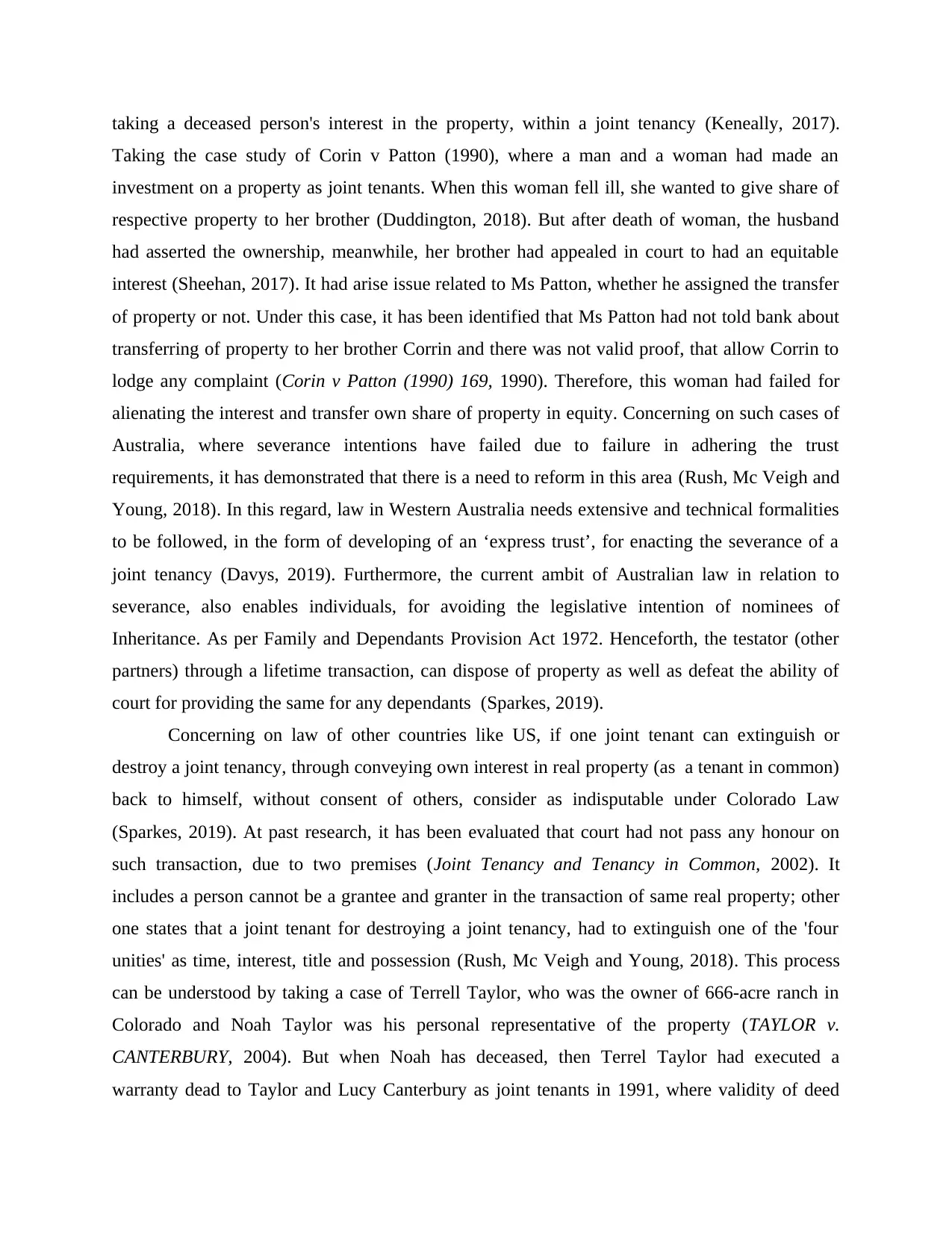
taking a deceased person's interest in the property, within a joint tenancy (Keneally, 2017).
Taking the case study of Corin v Patton (1990), where a man and a woman had made an
investment on a property as joint tenants. When this woman fell ill, she wanted to give share of
respective property to her brother (Duddington, 2018). But after death of woman, the husband
had asserted the ownership, meanwhile, her brother had appealed in court to had an equitable
interest (Sheehan, 2017). It had arise issue related to Ms Patton, whether he assigned the transfer
of property or not. Under this case, it has been identified that Ms Patton had not told bank about
transferring of property to her brother Corrin and there was not valid proof, that allow Corrin to
lodge any complaint (Corin v Patton (1990) 169, 1990). Therefore, this woman had failed for
alienating the interest and transfer own share of property in equity. Concerning on such cases of
Australia, where severance intentions have failed due to failure in adhering the trust
requirements, it has demonstrated that there is a need to reform in this area (Rush, Mc Veigh and
Young, 2018). In this regard, law in Western Australia needs extensive and technical formalities
to be followed, in the form of developing of an ‘express trust’, for enacting the severance of a
joint tenancy (Davys, 2019). Furthermore, the current ambit of Australian law in relation to
severance, also enables individuals, for avoiding the legislative intention of nominees of
Inheritance. As per Family and Dependants Provision Act 1972. Henceforth, the testator (other
partners) through a lifetime transaction, can dispose of property as well as defeat the ability of
court for providing the same for any dependants (Sparkes, 2019).
Concerning on law of other countries like US, if one joint tenant can extinguish or
destroy a joint tenancy, through conveying own interest in real property (as a tenant in common)
back to himself, without consent of others, consider as indisputable under Colorado Law
(Sparkes, 2019). At past research, it has been evaluated that court had not pass any honour on
such transaction, due to two premises (Joint Tenancy and Tenancy in Common, 2002). It
includes a person cannot be a grantee and granter in the transaction of same real property; other
one states that a joint tenant for destroying a joint tenancy, had to extinguish one of the 'four
unities' as time, interest, title and possession (Rush, Mc Veigh and Young, 2018). This process
can be understood by taking a case of Terrell Taylor, who was the owner of 666-acre ranch in
Colorado and Noah Taylor was his personal representative of the property (TAYLOR v.
CANTERBURY, 2004). But when Noah has deceased, then Terrel Taylor had executed a
warranty dead to Taylor and Lucy Canterbury as joint tenants in 1991, where validity of deed
Taking the case study of Corin v Patton (1990), where a man and a woman had made an
investment on a property as joint tenants. When this woman fell ill, she wanted to give share of
respective property to her brother (Duddington, 2018). But after death of woman, the husband
had asserted the ownership, meanwhile, her brother had appealed in court to had an equitable
interest (Sheehan, 2017). It had arise issue related to Ms Patton, whether he assigned the transfer
of property or not. Under this case, it has been identified that Ms Patton had not told bank about
transferring of property to her brother Corrin and there was not valid proof, that allow Corrin to
lodge any complaint (Corin v Patton (1990) 169, 1990). Therefore, this woman had failed for
alienating the interest and transfer own share of property in equity. Concerning on such cases of
Australia, where severance intentions have failed due to failure in adhering the trust
requirements, it has demonstrated that there is a need to reform in this area (Rush, Mc Veigh and
Young, 2018). In this regard, law in Western Australia needs extensive and technical formalities
to be followed, in the form of developing of an ‘express trust’, for enacting the severance of a
joint tenancy (Davys, 2019). Furthermore, the current ambit of Australian law in relation to
severance, also enables individuals, for avoiding the legislative intention of nominees of
Inheritance. As per Family and Dependants Provision Act 1972. Henceforth, the testator (other
partners) through a lifetime transaction, can dispose of property as well as defeat the ability of
court for providing the same for any dependants (Sparkes, 2019).
Concerning on law of other countries like US, if one joint tenant can extinguish or
destroy a joint tenancy, through conveying own interest in real property (as a tenant in common)
back to himself, without consent of others, consider as indisputable under Colorado Law
(Sparkes, 2019). At past research, it has been evaluated that court had not pass any honour on
such transaction, due to two premises (Joint Tenancy and Tenancy in Common, 2002). It
includes a person cannot be a grantee and granter in the transaction of same real property; other
one states that a joint tenant for destroying a joint tenancy, had to extinguish one of the 'four
unities' as time, interest, title and possession (Rush, Mc Veigh and Young, 2018). This process
can be understood by taking a case of Terrell Taylor, who was the owner of 666-acre ranch in
Colorado and Noah Taylor was his personal representative of the property (TAYLOR v.
CANTERBURY, 2004). But when Noah has deceased, then Terrel Taylor had executed a
warranty dead to Taylor and Lucy Canterbury as joint tenants in 1991, where validity of deed
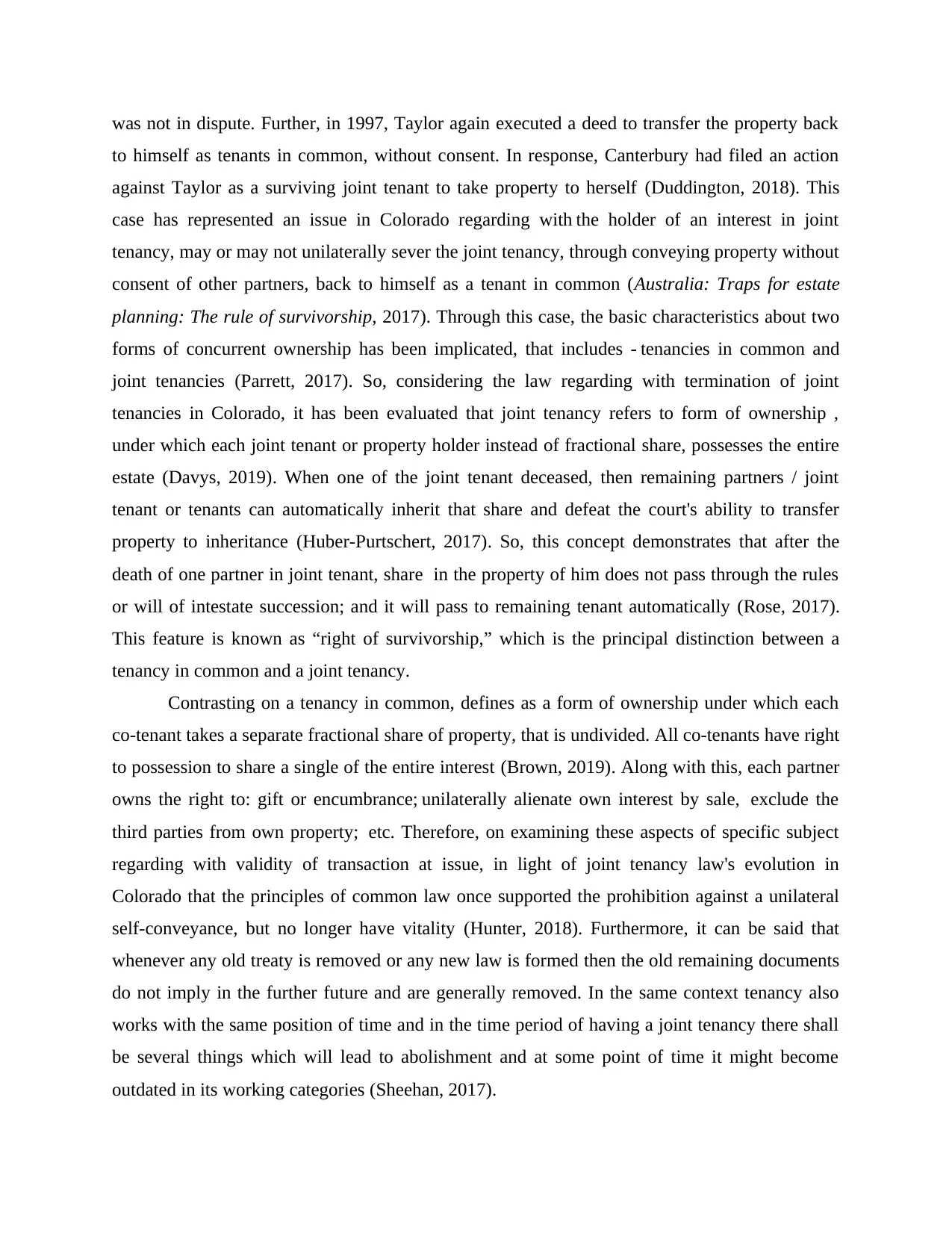
was not in dispute. Further, in 1997, Taylor again executed a deed to transfer the property back
to himself as tenants in common, without consent. In response, Canterbury had filed an action
against Taylor as a surviving joint tenant to take property to herself (Duddington, 2018). This
case has represented an issue in Colorado regarding with the holder of an interest in joint
tenancy, may or may not unilaterally sever the joint tenancy, through conveying property without
consent of other partners, back to himself as a tenant in common (Australia: Traps for estate
planning: The rule of survivorship, 2017). Through this case, the basic characteristics about two
forms of concurrent ownership has been implicated, that includes - tenancies in common and
joint tenancies (Parrett, 2017). So, considering the law regarding with termination of joint
tenancies in Colorado, it has been evaluated that joint tenancy refers to form of ownership ,
under which each joint tenant or property holder instead of fractional share, possesses the entire
estate (Davys, 2019). When one of the joint tenant deceased, then remaining partners / joint
tenant or tenants can automatically inherit that share and defeat the court's ability to transfer
property to inheritance (Huber-Purtschert, 2017). So, this concept demonstrates that after the
death of one partner in joint tenant, share in the property of him does not pass through the rules
or will of intestate succession; and it will pass to remaining tenant automatically (Rose, 2017).
This feature is known as “right of survivorship,” which is the principal distinction between a
tenancy in common and a joint tenancy.
Contrasting on a tenancy in common, defines as a form of ownership under which each
co-tenant takes a separate fractional share of property, that is undivided. All co-tenants have right
to possession to share a single of the entire interest (Brown, 2019). Along with this, each partner
owns the right to: gift or encumbrance; unilaterally alienate own interest by sale, exclude the
third parties from own property; etc. Therefore, on examining these aspects of specific subject
regarding with validity of transaction at issue, in light of joint tenancy law's evolution in
Colorado that the principles of common law once supported the prohibition against a unilateral
self-conveyance, but no longer have vitality (Hunter, 2018). Furthermore, it can be said that
whenever any old treaty is removed or any new law is formed then the old remaining documents
do not imply in the further future and are generally removed. In the same context tenancy also
works with the same position of time and in the time period of having a joint tenancy there shall
be several things which will lead to abolishment and at some point of time it might become
outdated in its working categories (Sheehan, 2017).
to himself as tenants in common, without consent. In response, Canterbury had filed an action
against Taylor as a surviving joint tenant to take property to herself (Duddington, 2018). This
case has represented an issue in Colorado regarding with the holder of an interest in joint
tenancy, may or may not unilaterally sever the joint tenancy, through conveying property without
consent of other partners, back to himself as a tenant in common (Australia: Traps for estate
planning: The rule of survivorship, 2017). Through this case, the basic characteristics about two
forms of concurrent ownership has been implicated, that includes - tenancies in common and
joint tenancies (Parrett, 2017). So, considering the law regarding with termination of joint
tenancies in Colorado, it has been evaluated that joint tenancy refers to form of ownership ,
under which each joint tenant or property holder instead of fractional share, possesses the entire
estate (Davys, 2019). When one of the joint tenant deceased, then remaining partners / joint
tenant or tenants can automatically inherit that share and defeat the court's ability to transfer
property to inheritance (Huber-Purtschert, 2017). So, this concept demonstrates that after the
death of one partner in joint tenant, share in the property of him does not pass through the rules
or will of intestate succession; and it will pass to remaining tenant automatically (Rose, 2017).
This feature is known as “right of survivorship,” which is the principal distinction between a
tenancy in common and a joint tenancy.
Contrasting on a tenancy in common, defines as a form of ownership under which each
co-tenant takes a separate fractional share of property, that is undivided. All co-tenants have right
to possession to share a single of the entire interest (Brown, 2019). Along with this, each partner
owns the right to: gift or encumbrance; unilaterally alienate own interest by sale, exclude the
third parties from own property; etc. Therefore, on examining these aspects of specific subject
regarding with validity of transaction at issue, in light of joint tenancy law's evolution in
Colorado that the principles of common law once supported the prohibition against a unilateral
self-conveyance, but no longer have vitality (Hunter, 2018). Furthermore, it can be said that
whenever any old treaty is removed or any new law is formed then the old remaining documents
do not imply in the further future and are generally removed. In the same context tenancy also
works with the same position of time and in the time period of having a joint tenancy there shall
be several things which will lead to abolishment and at some point of time it might become
outdated in its working categories (Sheehan, 2017).
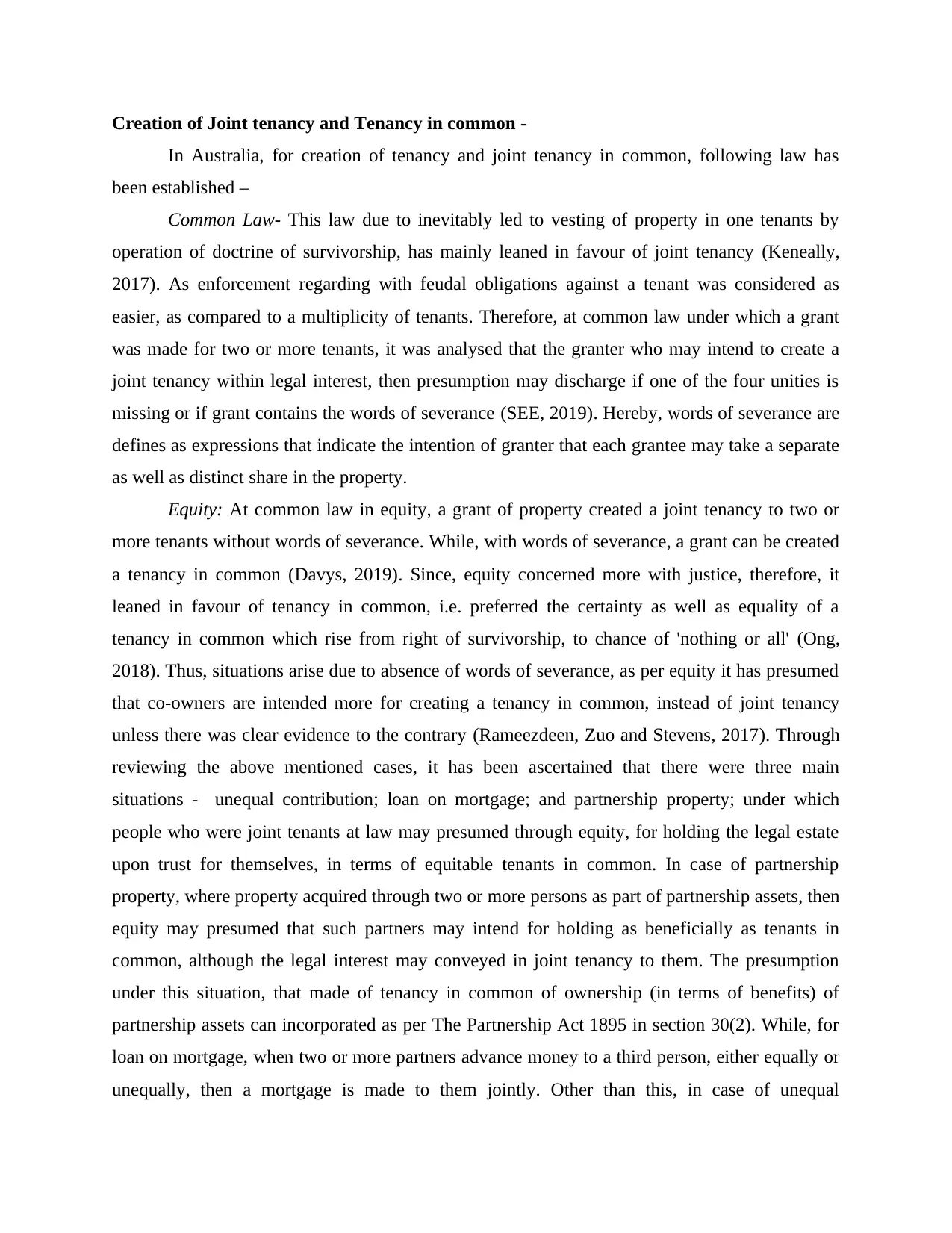
Creation of Joint tenancy and Tenancy in common -
In Australia, for creation of tenancy and joint tenancy in common, following law has
been established –
Common Law- This law due to inevitably led to vesting of property in one tenants by
operation of doctrine of survivorship, has mainly leaned in favour of joint tenancy (Keneally,
2017). As enforcement regarding with feudal obligations against a tenant was considered as
easier, as compared to a multiplicity of tenants. Therefore, at common law under which a grant
was made for two or more tenants, it was analysed that the granter who may intend to create a
joint tenancy within legal interest, then presumption may discharge if one of the four unities is
missing or if grant contains the words of severance (SEE, 2019). Hereby, words of severance are
defines as expressions that indicate the intention of granter that each grantee may take a separate
as well as distinct share in the property.
Equity: At common law in equity, a grant of property created a joint tenancy to two or
more tenants without words of severance. While, with words of severance, a grant can be created
a tenancy in common (Davys, 2019). Since, equity concerned more with justice, therefore, it
leaned in favour of tenancy in common, i.e. preferred the certainty as well as equality of a
tenancy in common which rise from right of survivorship, to chance of 'nothing or all' (Ong,
2018). Thus, situations arise due to absence of words of severance, as per equity it has presumed
that co-owners are intended more for creating a tenancy in common, instead of joint tenancy
unless there was clear evidence to the contrary (Rameezdeen, Zuo and Stevens, 2017). Through
reviewing the above mentioned cases, it has been ascertained that there were three main
situations - unequal contribution; loan on mortgage; and partnership property; under which
people who were joint tenants at law may presumed through equity, for holding the legal estate
upon trust for themselves, in terms of equitable tenants in common. In case of partnership
property, where property acquired through two or more persons as part of partnership assets, then
equity may presumed that such partners may intend for holding as beneficially as tenants in
common, although the legal interest may conveyed in joint tenancy to them. The presumption
under this situation, that made of tenancy in common of ownership (in terms of benefits) of
partnership assets can incorporated as per The Partnership Act 1895 in section 30(2). While, for
loan on mortgage, when two or more partners advance money to a third person, either equally or
unequally, then a mortgage is made to them jointly. Other than this, in case of unequal
In Australia, for creation of tenancy and joint tenancy in common, following law has
been established –
Common Law- This law due to inevitably led to vesting of property in one tenants by
operation of doctrine of survivorship, has mainly leaned in favour of joint tenancy (Keneally,
2017). As enforcement regarding with feudal obligations against a tenant was considered as
easier, as compared to a multiplicity of tenants. Therefore, at common law under which a grant
was made for two or more tenants, it was analysed that the granter who may intend to create a
joint tenancy within legal interest, then presumption may discharge if one of the four unities is
missing or if grant contains the words of severance (SEE, 2019). Hereby, words of severance are
defines as expressions that indicate the intention of granter that each grantee may take a separate
as well as distinct share in the property.
Equity: At common law in equity, a grant of property created a joint tenancy to two or
more tenants without words of severance. While, with words of severance, a grant can be created
a tenancy in common (Davys, 2019). Since, equity concerned more with justice, therefore, it
leaned in favour of tenancy in common, i.e. preferred the certainty as well as equality of a
tenancy in common which rise from right of survivorship, to chance of 'nothing or all' (Ong,
2018). Thus, situations arise due to absence of words of severance, as per equity it has presumed
that co-owners are intended more for creating a tenancy in common, instead of joint tenancy
unless there was clear evidence to the contrary (Rameezdeen, Zuo and Stevens, 2017). Through
reviewing the above mentioned cases, it has been ascertained that there were three main
situations - unequal contribution; loan on mortgage; and partnership property; under which
people who were joint tenants at law may presumed through equity, for holding the legal estate
upon trust for themselves, in terms of equitable tenants in common. In case of partnership
property, where property acquired through two or more persons as part of partnership assets, then
equity may presumed that such partners may intend for holding as beneficially as tenants in
common, although the legal interest may conveyed in joint tenancy to them. The presumption
under this situation, that made of tenancy in common of ownership (in terms of benefits) of
partnership assets can incorporated as per The Partnership Act 1895 in section 30(2). While, for
loan on mortgage, when two or more partners advance money to a third person, either equally or
unequally, then a mortgage is made to them jointly. Other than this, in case of unequal
Secure Best Marks with AI Grader
Need help grading? Try our AI Grader for instant feedback on your assignments.
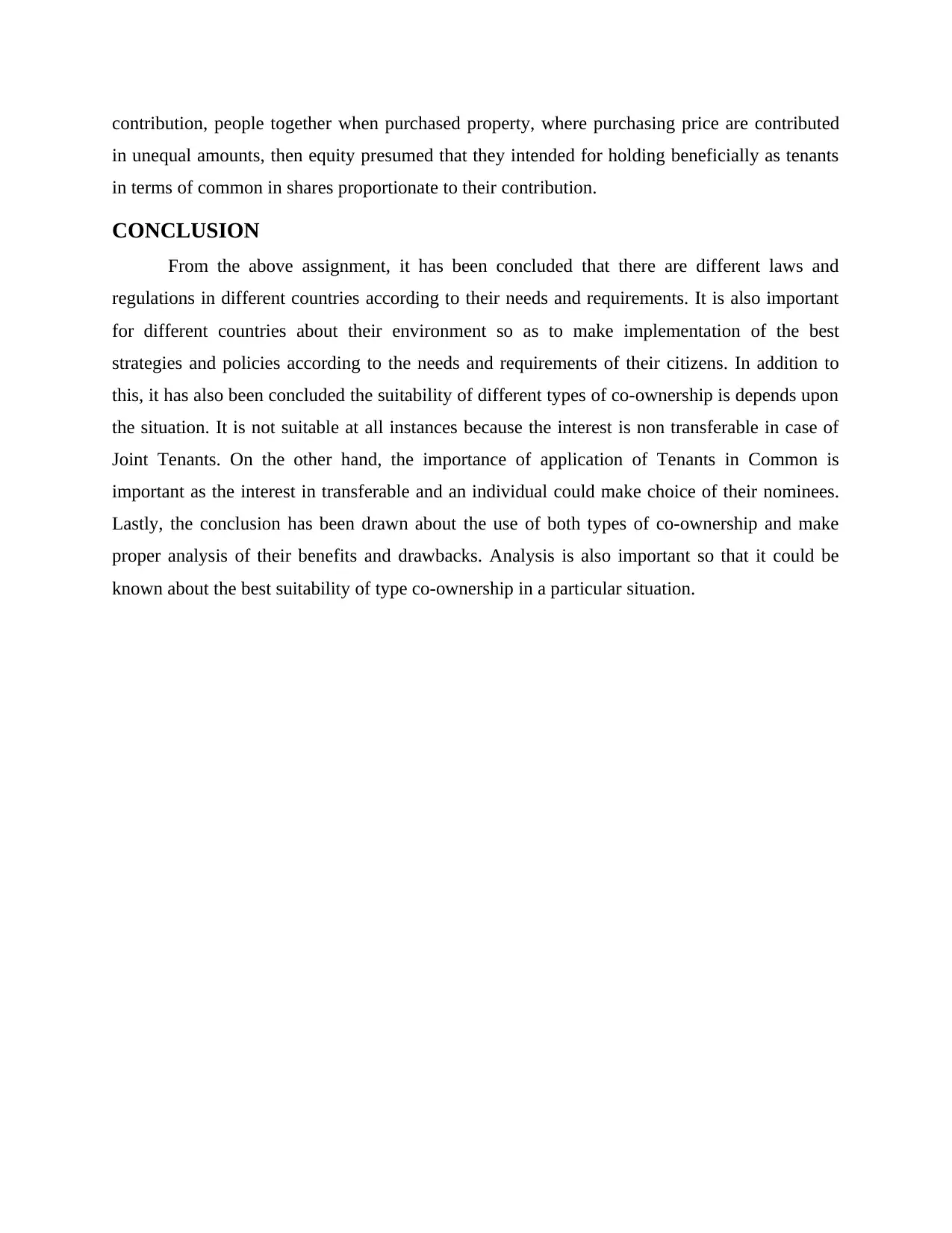
contribution, people together when purchased property, where purchasing price are contributed
in unequal amounts, then equity presumed that they intended for holding beneficially as tenants
in terms of common in shares proportionate to their contribution.
CONCLUSION
From the above assignment, it has been concluded that there are different laws and
regulations in different countries according to their needs and requirements. It is also important
for different countries about their environment so as to make implementation of the best
strategies and policies according to the needs and requirements of their citizens. In addition to
this, it has also been concluded the suitability of different types of co-ownership is depends upon
the situation. It is not suitable at all instances because the interest is non transferable in case of
Joint Tenants. On the other hand, the importance of application of Tenants in Common is
important as the interest in transferable and an individual could make choice of their nominees.
Lastly, the conclusion has been drawn about the use of both types of co-ownership and make
proper analysis of their benefits and drawbacks. Analysis is also important so that it could be
known about the best suitability of type co-ownership in a particular situation.
in unequal amounts, then equity presumed that they intended for holding beneficially as tenants
in terms of common in shares proportionate to their contribution.
CONCLUSION
From the above assignment, it has been concluded that there are different laws and
regulations in different countries according to their needs and requirements. It is also important
for different countries about their environment so as to make implementation of the best
strategies and policies according to the needs and requirements of their citizens. In addition to
this, it has also been concluded the suitability of different types of co-ownership is depends upon
the situation. It is not suitable at all instances because the interest is non transferable in case of
Joint Tenants. On the other hand, the importance of application of Tenants in Common is
important as the interest in transferable and an individual could make choice of their nominees.
Lastly, the conclusion has been drawn about the use of both types of co-ownership and make
proper analysis of their benefits and drawbacks. Analysis is also important so that it could be
known about the best suitability of type co-ownership in a particular situation.
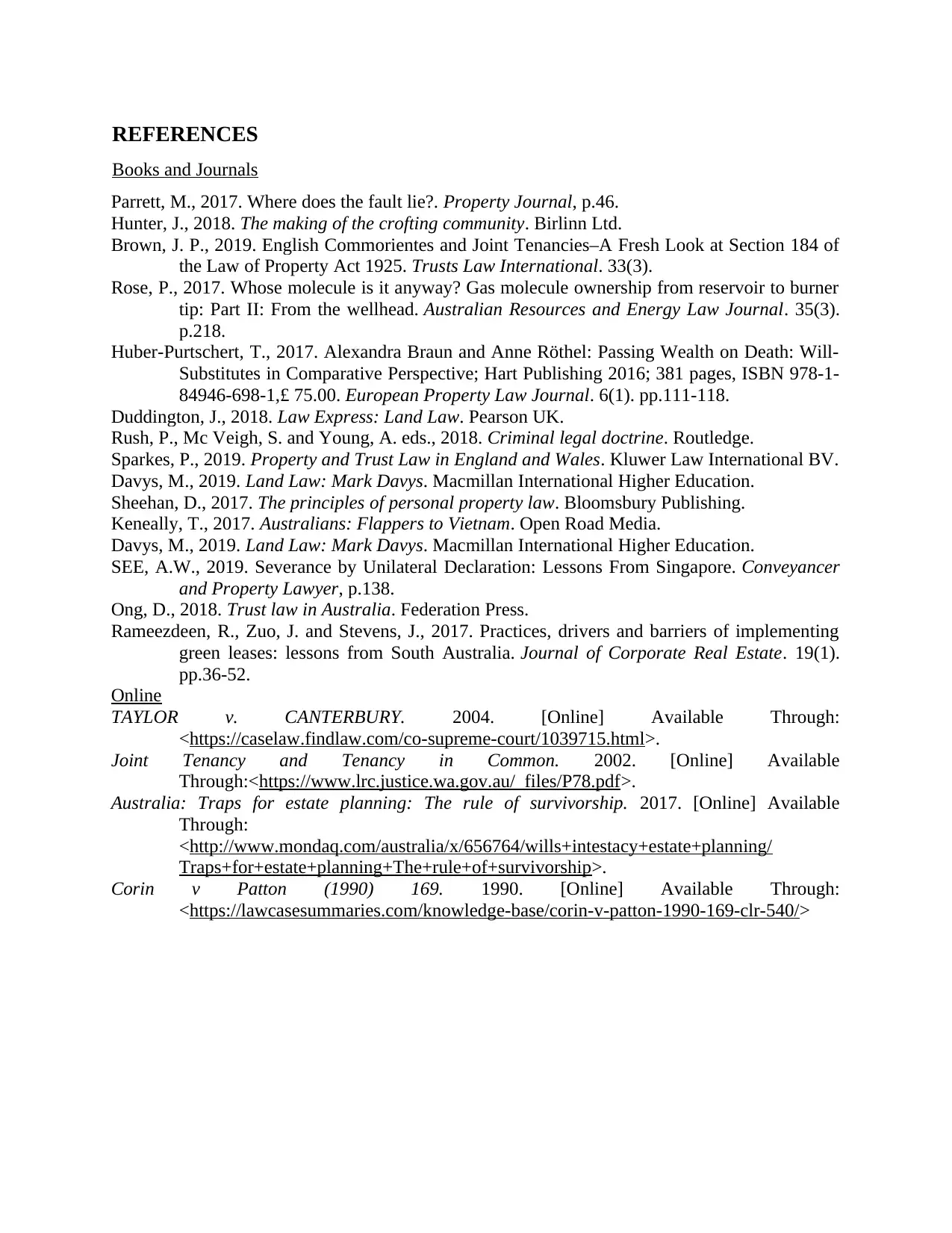
REFERENCES
Books and Journals
Parrett, M., 2017. Where does the fault lie?. Property Journal, p.46.
Hunter, J., 2018. The making of the crofting community. Birlinn Ltd.
Brown, J. P., 2019. English Commorientes and Joint Tenancies–A Fresh Look at Section 184 of
the Law of Property Act 1925. Trusts Law International. 33(3).
Rose, P., 2017. Whose molecule is it anyway? Gas molecule ownership from reservoir to burner
tip: Part II: From the wellhead. Australian Resources and Energy Law Journal. 35(3).
p.218.
Huber-Purtschert, T., 2017. Alexandra Braun and Anne Röthel: Passing Wealth on Death: Will-
Substitutes in Comparative Perspective; Hart Publishing 2016; 381 pages, ISBN 978-1-
84946-698-1,£ 75.00. European Property Law Journal. 6(1). pp.111-118.
Duddington, J., 2018. Law Express: Land Law. Pearson UK.
Rush, P., Mc Veigh, S. and Young, A. eds., 2018. Criminal legal doctrine. Routledge.
Sparkes, P., 2019. Property and Trust Law in England and Wales. Kluwer Law International BV.
Davys, M., 2019. Land Law: Mark Davys. Macmillan International Higher Education.
Sheehan, D., 2017. The principles of personal property law. Bloomsbury Publishing.
Keneally, T., 2017. Australians: Flappers to Vietnam. Open Road Media.
Davys, M., 2019. Land Law: Mark Davys. Macmillan International Higher Education.
SEE, A.W., 2019. Severance by Unilateral Declaration: Lessons From Singapore. Conveyancer
and Property Lawyer, p.138.
Ong, D., 2018. Trust law in Australia. Federation Press.
Rameezdeen, R., Zuo, J. and Stevens, J., 2017. Practices, drivers and barriers of implementing
green leases: lessons from South Australia. Journal of Corporate Real Estate. 19(1).
pp.36-52.
Online
TAYLOR v. CANTERBURY. 2004. [Online] Available Through:
<https://caselaw.findlaw.com/co-supreme-court/1039715.html>.
Joint Tenancy and Tenancy in Common. 2002. [Online] Available
Through:<https://www.lrc.justice.wa.gov.au/_files/P78.pdf>.
Australia: Traps for estate planning: The rule of survivorship. 2017. [Online] Available
Through:
<http://www.mondaq.com/australia/x/656764/wills+intestacy+estate+planning/
Traps+for+estate+planning+The+rule+of+survivorship>.
Corin v Patton (1990) 169. 1990. [Online] Available Through:
<https://lawcasesummaries.com/knowledge-base/corin-v-patton-1990-169-clr-540/>
Books and Journals
Parrett, M., 2017. Where does the fault lie?. Property Journal, p.46.
Hunter, J., 2018. The making of the crofting community. Birlinn Ltd.
Brown, J. P., 2019. English Commorientes and Joint Tenancies–A Fresh Look at Section 184 of
the Law of Property Act 1925. Trusts Law International. 33(3).
Rose, P., 2017. Whose molecule is it anyway? Gas molecule ownership from reservoir to burner
tip: Part II: From the wellhead. Australian Resources and Energy Law Journal. 35(3).
p.218.
Huber-Purtschert, T., 2017. Alexandra Braun and Anne Röthel: Passing Wealth on Death: Will-
Substitutes in Comparative Perspective; Hart Publishing 2016; 381 pages, ISBN 978-1-
84946-698-1,£ 75.00. European Property Law Journal. 6(1). pp.111-118.
Duddington, J., 2018. Law Express: Land Law. Pearson UK.
Rush, P., Mc Veigh, S. and Young, A. eds., 2018. Criminal legal doctrine. Routledge.
Sparkes, P., 2019. Property and Trust Law in England and Wales. Kluwer Law International BV.
Davys, M., 2019. Land Law: Mark Davys. Macmillan International Higher Education.
Sheehan, D., 2017. The principles of personal property law. Bloomsbury Publishing.
Keneally, T., 2017. Australians: Flappers to Vietnam. Open Road Media.
Davys, M., 2019. Land Law: Mark Davys. Macmillan International Higher Education.
SEE, A.W., 2019. Severance by Unilateral Declaration: Lessons From Singapore. Conveyancer
and Property Lawyer, p.138.
Ong, D., 2018. Trust law in Australia. Federation Press.
Rameezdeen, R., Zuo, J. and Stevens, J., 2017. Practices, drivers and barriers of implementing
green leases: lessons from South Australia. Journal of Corporate Real Estate. 19(1).
pp.36-52.
Online
TAYLOR v. CANTERBURY. 2004. [Online] Available Through:
<https://caselaw.findlaw.com/co-supreme-court/1039715.html>.
Joint Tenancy and Tenancy in Common. 2002. [Online] Available
Through:<https://www.lrc.justice.wa.gov.au/_files/P78.pdf>.
Australia: Traps for estate planning: The rule of survivorship. 2017. [Online] Available
Through:
<http://www.mondaq.com/australia/x/656764/wills+intestacy+estate+planning/
Traps+for+estate+planning+The+rule+of+survivorship>.
Corin v Patton (1990) 169. 1990. [Online] Available Through:
<https://lawcasesummaries.com/knowledge-base/corin-v-patton-1990-169-clr-540/>
1 out of 12
Your All-in-One AI-Powered Toolkit for Academic Success.
+13062052269
info@desklib.com
Available 24*7 on WhatsApp / Email
![[object Object]](/_next/static/media/star-bottom.7253800d.svg)
Unlock your academic potential
© 2024 | Zucol Services PVT LTD | All rights reserved.


